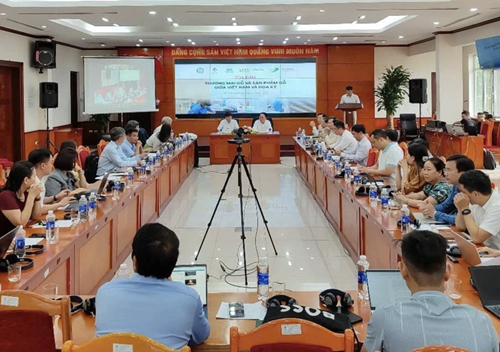Speaking at a workshop on Vietnam-U.S. timber and wooden product trade held on June 24 by the Department of Forestry and Forest Protection under the Ministry of Agriculture and Environment, Vietnam’s leading timber associations and Forest Trends, Vice Chairman and Secretary General of the Vietnam Timber and Forest Products Association (VIFOREST) Ngo Sy Hoai said that in 2024, Vietnam exported wood and wood products worth 9 billion USD to the U.S., up 24% year-on-year.
    |
 |
|
An overview of the workshop |
The U.S. remained Vietnam’s largest market, accounting for 55% of the country's total wood exports. Key products include wooden furniture, plywood, doors, and handicrafts.
Meanwhile, Vietnam imported 316.36 million USD worth of timber from the U.S. in 2024, up 32.9% year-on-year, accounting for 11.2% of Vietnam's total wood imports. The top three imported items were sawn timber, logs, and veneer.
Hoai stressed that the U.S.'s regulations, such as the Lacey Act, require wood imports to be legal and traceable. Exporters must comply with documentation requirements including export certificates and self-certification of origin. Meanwhile, Vietnam has banned natural forest logging since 2014, focusing instead on sustainable plantation forestry. The country now relies mainly on 3 million hectares of planted forests, mainly acacia and eucalyptus and 1 million hectares of rubber plantations.
Until now, 700,000 ha of commercial forests in Vietnam have been certified under the Forest Stewardship Council (FSC) or the Program for the Endorsement of Forest Certification (PEFC) standards. Vietnam aims to reach 70% certified plantation coverage by 2030. Imports of tropical timber into Vietnam have dropped significantly, from over 2 million cubic meters in 2015 to 700,000 cubic meters in 2024.
Vietnam’s Timber Legality Assurance System (VNTLAS), which was developed under a voluntary partnership agreement (VPA) between the European Union and Vietnam on forest law enforcement, governance and trade (FLEGT), was launched in 2020, updated in 2024, and is now preparing for licensing. The U.S. is considered a positive and reliable supplier of legal timber.
Vietnam is also preparing to comply with the EU’s Deforestation Regulation (EUDR), requiring companies in sectors like wood, coffee, and rubber to provide geolocation data and evidence of legal sourcing.
Hoai highlighted that Vietnam has become one of the top suppliers of timber to the U.S., and one of the largest importers of U.S. wood. He said both sides have strictly followed regulations, including the Lacey Act, and effectively resolved trade disputes, such as the U.S. Section 301 investigation. He called for continued collaboration to promote legal, sustainable, and mutually beneficial timber trade between the two countries.
At the workshop, Director of the Department of Forestry and Forest Protection Tran Quang Bao also revealed that new regulations, including those related to business classification, traceability of forest products, geographical zoning are expected to be issued this month.
    |
 |
|
Director of the Department of Forestry and Forest Protection Tran Quang Bao speaks at the workshop. |
The regulations will help develop a transparent digital transformation system, meeting the requirements of traceability when necessary, Bao said.
He noted that his department is ready to accompany associations and businesses to assure international partners that Vietnam is a tropical country but has closed natural forests. Vietnam does not use wood materials from natural forests for export and is completely transparent in the supply chain and legal system.
Source: VNA